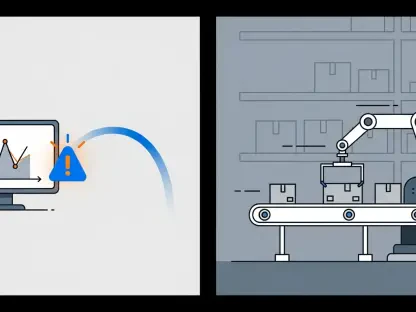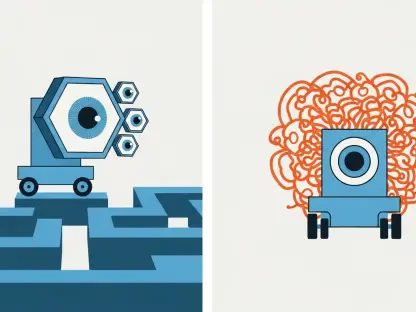Setting the Stage for Trust in AI
In an era where artificial intelligence drives decisions in critical sectors like healthcare and finance, a staggering concern looms large: nearly 60% of enterprise leaders express skepticism about AI reliability, according to recent industry surveys. This distrust stems from high-profile failures, such as erroneous medical diagnoses or flawed financial predictions, which highlight the urgent need for systems that can be depended upon. The stakes are high, as AI’s potential to revolutionize industries hinges on overcoming these trust barriers, ensuring that outputs are not just innovative but also safe and accurate.
This review delves into the evolving landscape of AI trustworthiness solutions, examining how cutting-edge technologies are addressing these pressing challenges. By focusing on the mechanisms that bolster reliability and efficiency, the discussion aims to illuminate the path toward widespread AI adoption. From healthcare diagnostics to enterprise data analysis, the quest for trustworthy AI is reshaping how technology integrates into daily operations.
Defining the Core of AI Trustworthiness
At its essence, AI trustworthiness refers to the capacity of systems to produce reliable, accurate, and safe results while fostering user confidence in their functionality. This concept is paramount in environments where errors can have severe consequences, such as in predictive models for patient care or algorithmic trading platforms. Trustworthiness ensures that AI does not merely perform tasks but does so with a level of dependability that stakeholders can rely on.
The challenges undermining trust are multifaceted, including model uncertainty, where systems struggle to gauge their own accuracy, and hallucinations in large language models (LLMs), which generate fabricated or incorrect information. Additionally, computational inefficiencies often exacerbate these issues, as resource-heavy processes can delay critical outputs or compromise precision. Addressing these hurdles is vital for scaling AI applications in sensitive domains.
The significance of trustworthiness extends across the AI ecosystem, particularly in high-stakes enterprise settings where decisions impact lives and livelihoods. As industries increasingly lean on AI for strategic insights, the demand for systems that can be trusted—both technically and ethically—becomes non-negotiable. This foundation sets the stage for exploring innovative solutions that aim to bridge the trust gap.
Innovations Driving AI Reliability
Bolstering Safety with Uncertainty Detection
One of the foremost strategies in enhancing AI trustworthiness lies in detecting and mitigating uncertainty within model outputs. Techniques such as neural network probes are being deployed to scrutinize LLMs, identifying when responses might be unreliable. By flagging questionable outputs, these methods provide a safety net for applications where precision is critical, such as legal document analysis or medical advisory systems.
Further depth is added through advanced analysis of hidden states, gradient scores, and prompt sensitivity, which collectively pinpoint data quality issues or unpredictable areas within datasets. This detailed approach ensures that systems can self-assess their limitations, alerting users to potential errors before they manifest as real-world problems. Such innovations are pivotal for industries that cannot afford missteps, reinforcing AI’s role as a dependable partner.
Anchoring Responses with Knowledge Bases
Another transformative approach involves grounding AI outputs in verified external knowledge bases to curb hallucinations. Reinforcement learning frameworks integrate structured data from sources like Freebase and Wikidata, enhancing the accuracy of responses by tethering them to factual information. This method is particularly effective in reducing the generation of unfounded content, a common pitfall in conversational AI.
The adoption of single-agent, multi-turn systems within these frameworks also optimizes efficiency, balancing completeness with transparency. Compared to traditional multi-agent setups, this streamlined process cuts computational costs while maintaining high standards of reliability. The result is a more practical solution for enterprise applications, where both accuracy and resource management are key considerations.
Pushing Boundaries in Computational Efficiency
Refining Transformer Architectures
Efficiency remains a cornerstone of trustworthy AI, with innovations in transformer models leading the charge. Linear attention mechanisms are replacing older, resource-intensive softmax attention, significantly reducing computational complexity. This shift allows AI systems to scale effectively, handling larger datasets and longer inputs without sacrificing performance.
Hybrid architectures, combining various attention types, further enhance adaptability to complex tasks. Coupled with dynamic positional encodings, these models achieve richer interactions within data, streamlining inference processes. Such advancements ensure that AI can deliver timely results, a critical factor in time-sensitive environments like financial forecasting or emergency response systems.
Harmonizing Speed with Dependability
The interplay between speed and reliability is a delicate balance that recent developments strive to perfect. Enhancements in processing capabilities are designed to complement safety protocols, ensuring that quicker outputs do not undermine accuracy. This synergy is essential for maintaining user trust, as delays or errors can erode confidence in AI tools.
By prioritizing both rapid computation and robust safety measures, these solutions cater to real-time demands without cutting corners. Industries relying on instantaneous data analysis benefit immensely, as they gain access to AI systems that are both swift and steadfast. This dual focus underscores the holistic approach needed for trustworthy technology.
Practical Impacts Across Industries
Trustworthiness solutions are making tangible differences in sectors where reliability is paramount. In finance, AI systems equipped with uncertainty detection are improving risk assessments, ensuring that algorithmic predictions align with market realities. Similarly, healthcare applications leverage these tools for diagnostic accuracy, minimizing errors in patient evaluations.
Specific use cases further illustrate this impact, such as visual document understanding for chart analysis in corporate settings. By processing multimodal data, AI aids in extracting actionable insights from complex visualizations, streamlining decision-making processes. Additionally, texture generation for computer-aided design showcases how trustworthiness extends to creative fields, enhancing precision in material simulations.
These deployments highlight the versatility of trustworthy AI, proving its value beyond theoretical advancements. From enterprise analytics to design innovation, the ability to rely on AI outputs transforms operational workflows, fostering greater integration of technology into strategic frameworks.
Navigating Obstacles in Trustworthy AI Development
Despite progress, significant technical challenges persist in building trustworthy AI. Detecting uncertainty across diverse datasets remains complex, as varying data structures and contexts complicate uniform solutions. Scaling efficient models for broad adoption also poses difficulties, often requiring substantial resources that may not be universally accessible.
External factors, such as regulatory constraints, add another layer of hindrance, as compliance demands can slow innovation or limit implementation. User skepticism, fueled by past AI failures, further dampens enthusiasm for adopting new systems, necessitating robust education and transparency efforts to shift perceptions.
Ongoing research aims to address these barriers by focusing on cost-effective and user-friendly advancements. Efforts to simplify uncertainty detection and optimize scalability are underway, alongside initiatives to align with regulatory frameworks. These endeavors reflect a commitment to making trustworthy AI not just a concept but a practical reality.
Charting the Path Ahead for AI Trust
Looking forward, the trajectory of trustworthiness solutions points toward exciting possibilities, particularly in integrating multimodal data for more comprehensive AI capabilities. Refining knowledge-grounded reasoning also holds promise, as it could further minimize errors by anchoring outputs in verifiable facts, enhancing decision-making tools.
The long-term impact on industries and society could be profound, envisioning a landscape where AI is seamlessly embedded in critical processes without hesitation. As trust solidifies, sectors like education and public policy might increasingly rely on AI for insights, reshaping how challenges are approached on a global scale.
Emerging research areas, such as advanced safety protocols and energy-efficient algorithms, are poised to drive further improvements. These focus areas aim to tackle both technical and ethical dimensions of trust, ensuring that AI evolves as a force for good. The horizon is rich with potential for transformative change.
Reflecting on AI Trustworthiness Achievements
Looking back, the strides made in AI trustworthiness through uncertainty detection and computational efficiency marked a significant chapter in technology’s evolution. The integration of multimodal data expanded the horizons of what AI could achieve, proving its worth in diverse applications. These efforts laid a strong foundation for reliable systems that industries came to depend on.
Moving forward, the focus shifts to actionable steps like fostering collaboration between researchers and policymakers to address regulatory gaps. Investing in user education emerges as a priority to combat skepticism, ensuring that trust in AI is built through understanding. Additionally, continued innovation in scalable, cost-effective solutions promises to democratize access to trustworthy tools, paving the way for broader societal benefits.









